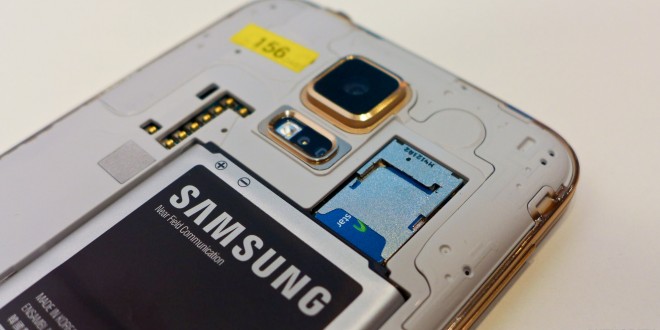When it comes to any kind of smartphone, many people aim for the best battery life they can get their hands on. Nonetheless, battery life on current smartphones isn’t very shiny as the technology hasn’t been perfected enough to offer good battery life on large high-definition displays. There are just a handful of devices that can hit a two-day battery life, which is surprising considering all the advancements in technology as of late. The Galaxy S5 and Galaxy Note 4 are the current flagships from Samsung and one of them is a leader in battery life. Can you guess which one? The Galaxy S5 was pretty criticized for the cheap design and surplus features nobody seemed to care too much for, but what can it present for itself in terms of battery life? Can it beat the massive Galaxy Note 4’s battery life or will its power dwindle in the face of advanced technology?
Galaxy S5 battery life is guaranteed by a 2,800 mAh battery unit which seems to be appropriate for a 5.1 inch 1080p display. But how does that battery fare in real life usage? According to our battery life tests using video playback, gaming, various high-intensity apps, flash photography and video recording, we found satisfying, albeit not out of the ordinary results. The Snapdragon 800 processor within the Galaxy S5 is equipped for high-end power-efficiency, but it isn’t the best of the best since the phone was launched. Nonetheless, the Galaxy S5 put to use without power saving options can rack up about a day and a half of use.
A day and a half of use seems like very little if you ever owned phones that are not smart. Those could stay on with calls and messages going in and out for a week at least. I’m sure we will get to that massive battery life in time, but at the moment, advancements in the field are slow. With average Wi-Fi internet use, some video playback and a few hours of music playback, the Galaxy S5 battery life still managed to keep itself up for a day and half. If you add 3G or 4G internet use, intensive gaming sessions and a photo- and video shoot, the battery will die at the end of the day. Still, the Galaxy S5 can play about 11 hours of average quality video in one go, which is pretty impressive for a high-def device.
If you make use of the battery saving options Samsung decided to include in the Galaxy S5, you can get almost two days of battery life out of it, but without using high-consumption apps and video recording. If you choose to activate Ultra Power Saving Mode, you can get up to 10 days of standby time out of the battery, but you will have very limited access to the phone’s functionality. With this mode, your Galaxy S5 will lose its colors, will restrict background data and you will only be able to use around 6 apps, including the browser. I wouldn’t recommend this power saving setting for everyday use, since it strips the handset of all the fun parts. Nonetheless, it is a handy feature to activate when you go on a trip or when you desperately need your battery life which stands at 10 % to last throughout the day.
The Galaxy Note 4 is the more impressive of the two in terms of battery life (and everything else, for that matter). Alongside the Sony Xperia Z4, it can actually two days of mixed use at average brightness without having to activate any battery saving features. That’s a great feat from a 5.7 inch QHD display-touting smartphone, so props to Samsung for that. That huge high-def screen is powered by a pretty large 3,220 mAh battery and the Snapdragon 805 CPU can be quite power-efficient compared to the Snapdragon 800. With heavy use including music streaming for a few hours, some video playback, an hour of gaming, a whole lot of social media and a bit of browsing, the Galaxy Note 4 battery life was left at about %20 at the end of the day, which means that you can use it in the morning on your commute, but by the time you get to work, it’l be dead for sure.
If you use the display on the Galaxy Note 4 much throughout the day, meaning video playback, gaming, various applications and such, your battery life will dwindle significantly, reducing it to about a day. Nonetheless, you can use the Ultra Power Saving Mode on the Galaxy Note 4 as well, which will get approximately the same results as it does on the Galaxy S5. What we noticed on our battery tests is that the Galaxy Note 4 battery life is outdone by its predecessor, the Note 3, which is understandable since we didn’t have such a QHD display on that handset. The display is the biggest power-drain on the Galaxy Note 4, naturally, but the big battery coupled with the Snapdragon 805 CPU make for pretty impressive results.
As a conclusion, we can safely say that the Galaxy S5 has a pretty average battery life compared to other flagships like the HTC One M8, LG G3, HTC One M7, Moto X 2014 and Nexus 6. Still, the Galaxy Note 4 might be the better choice if you want great battery life, as long as you use moderation on that massive QHD display. Whichever flagship you may get, you won’t be overly impressed with battery life, because the technology just hasn’t made it that far yet. Samsung and LG are working on graphene-based batteries, though, so we could see vastly increased battery lives on flagships of the future.
 Load the Game Video Games, Reviews, Game News, Game Reviews & Game Video Trailers
Load the Game Video Games, Reviews, Game News, Game Reviews & Game Video Trailers



